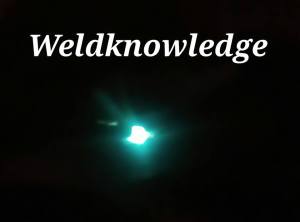Weld pool geometry is depended majorly on variables like velocity of the moving heat source(v), size (d)and thermal conductivity(Λ) of the material. The shape of the molten pool is like a distorted ellipse.The figure below shows the shape of the contour corresponding to the temperature of the liquidus.
The front end of the distorted ellipse denotes the location where melting is about to begin. The tail end of this contour denotes the region where solidification is over. The direction of crystal growth is perpendicular to the liquidus. The angle between the direction of growth and the velocity of the weld pool (v) is θ. The rate of crystal growth R is equal to vcosθ . It is the highest at θ = 0. This corresponds to the tail end. R is zero where v is tangent to the distorted ellipse (or the molten pool). This is the point on the moving weld pool beyond which there is no nucleation or crystal growth. Solidification begins from the edge of the solid surface soon after the weld pool moves away from the point where θ was 0 a little earlier. Several nuclei may form but only those that are favorably oriented would grow. Depending on the thermal gradient and the type of the alloy columnar or dendritic growth takes place. The alignment of the grains depends on the velocity, thermal conductivity and the size of the component. A major problem during this stage is the segregation of impurities. During solidification solute atoms are pushed towards the molten metal present along the centerline. This is the region that solidifies at the end. It consists of inclusions and precipitates. The centerline segregation is responsible for the poor toughness of weld joints. Higher the speed higher is the segregation.
The temperature of the solid interface may go beyond its melting point when it comes in contact with the molten pool of weld metal. A thin region of the parent metal may therefore melt and mix with the liquid. The region that melts and re‐solidifies is known as the fusion zone. The subsequent solidification is governed by nucleation and growth. The orientation of the grains that nucleate is exactly same as those at the solid‐liquid interface. In welding literature it is known epitaxial growth. The subsequent growth depends on the shape of the solidification front. This is influenced by the solute content in the molten weld metal, the thermal gradient (G) in the weld pool and the rate (R) at which the front moves forward. It follows from equation,
Tm denotes the melting point of the metal and xl is the distance between the heat source and the tail end of the molten weld pool. The melting point of a filler alloy is known. It is fixed. As v increases xl too would increase. Therefore high velocity of the weld pool means lower thermal gradient or G.
Apart from G & R the concentration of solute too has a pronounced effect on the microstructure that develops in the weld metal.
If thermal gradient at the solid liquid interface is greater than a critical value the interface is planar. This promotes columnar grains. The critical gradient depends on the solute buildup and the corresponding phase diagram. If it is a little lower, the buildup of solute at the interface leads to the formation of a cellular structure.
Reference: nptel literature
Keep reading, happy welding
Thank you,
KP Bhatt








